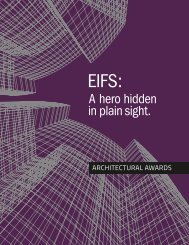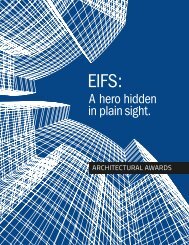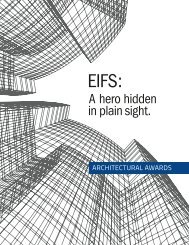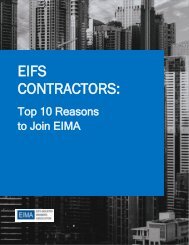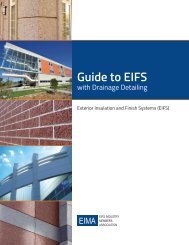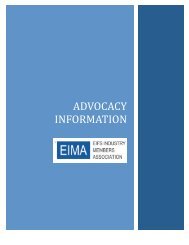Impact Resistant EIFS: Tough and Tested
EIFS are sustainable, durable, and resilient. Highly impact resistant EIFS are easily achievable using industry standard application practices and products that are very effective and economical. The keys to high impact resistant EIFS are the same as for any quality construction: good design; firm and definitive specifications; use of the proper products; and proper construction. This publication provides information and guidance to designers and specifiers regarding how to achieve impact resistant performance that is in line with project and owner expectations.
EIFS are sustainable, durable, and resilient. Highly impact resistant EIFS are easily achievable using industry standard application practices and products that are very effective and economical. The keys to high impact resistant EIFS are the same as for any quality construction: good design; firm and definitive specifications; use of the proper products; and proper construction. This publication provides information and guidance to designers and specifiers regarding how to achieve impact resistant performance that is in line with project and owner expectations.
Create successful ePaper yourself
Turn your PDF publications into a flip-book with our unique Google optimized e-Paper software.
IMPACT RESISTANT <strong>EIFS</strong>:<br />
<strong>Tough</strong> <strong>and</strong> <strong>Tested</strong><br />
Copyright 2019
About EIMA<br />
Sustainability <strong>and</strong> energy conservation are critical issues, <strong>and</strong> Exterior Insulation <strong>and</strong> Finish<br />
Systems (<strong>EIFS</strong>) are proven solutions to today's design challenges. The mission of the <strong>EIFS</strong><br />
Industry Members Association (EIMA) is the advancement <strong>and</strong> growth of <strong>EIFS</strong> in the United<br />
States. EIMA does this by promoting technical excellence through advocacy, industry<br />
st<strong>and</strong>ards, research, education <strong>and</strong> communication.<br />
The only national organization solely dedicated to the <strong>EIFS</strong> industry, EIMA strives to provide<br />
a seamless flow of information to all of its stakeholders: suppliers, manufacturers,<br />
distributors, contractors, architects <strong>and</strong> owners.<br />
Founded in 1981, the <strong>EIFS</strong> Industry Members Association (EIMA) is a national non-profit<br />
technical trade association comprised of leading suppliers, manufacturers, distributors,<br />
contractors, architects, related products manufacturers <strong>and</strong> suppliers, <strong>and</strong> other interested<br />
parties involved in the Exterior Insulation <strong>and</strong> Finish Systems (<strong>EIFS</strong>) industry.<br />
Solving Industry Challenges…<br />
EIMA's core objective is to promote the advancement <strong>and</strong> growth of <strong>EIFS</strong> while providing<br />
outst<strong>and</strong>ing industry representation <strong>and</strong> services to its members. EIMA develops technical,<br />
training, installation <strong>and</strong> design st<strong>and</strong>ards for use by architects, designers, code bodies <strong>and</strong><br />
other technical associations.<br />
EIMA monitors <strong>and</strong> positively influences government actions, <strong>and</strong> assures the long-term<br />
availability of qualified contractors. Over the years, many working relationships have been<br />
forged with national <strong>and</strong> regional contractor associations to address issues of common<br />
interest. In an effort to solve challenges facing the <strong>EIFS</strong> industry, EIMA actively encourages all<br />
elements of the construction community to work together <strong>and</strong> exchange information.<br />
Assuring St<strong>and</strong>ards of Quality…<br />
As an accredited ANSI st<strong>and</strong>ards organization, EIMA helps develop industry st<strong>and</strong>ards in an<br />
advisory capacity <strong>and</strong> educational programs that enable members to address important<br />
issues facing the <strong>EIFS</strong> <strong>and</strong> construction industries. Its Technical <strong>and</strong> Research Committee<br />
deals with a broad range of technical issues <strong>and</strong> represents the <strong>EIFS</strong> industry in negotiations<br />
with national building codes <strong>and</strong> st<strong>and</strong>ards agencies, as well as government regulators. In<br />
addition, the committee plans <strong>and</strong> implements research <strong>and</strong> testing programs, develops<br />
industry guideline specifications for <strong>EIFS</strong>, <strong>and</strong> presents at technical symposiums.<br />
www.eima.com
<strong>EIFS</strong> are sustainable, durable, <strong>and</strong> resilient. Highly impact resistant<br />
<strong>EIFS</strong> are easily achievable using industry st<strong>and</strong>ard application practices<br />
<strong>and</strong> products that are very effective <strong>and</strong> economical. The<br />
keys to high impact resistant <strong>EIFS</strong> are the same as for any quality<br />
construction: good design; firm <strong>and</strong> definitive specifications; use of<br />
the proper products; <strong>and</strong> proper construction. This document provides<br />
information <strong>and</strong> guidance to designers <strong>and</strong> specifiers regarding<br />
how to achieve impact resistant performance that is in line with<br />
project <strong>and</strong> owner expectations.<br />
<strong>Impact</strong> Resistance Requirements<br />
What level of impact resistance does your building require? Every project<br />
is different, but one common expectation of every owner is that they<br />
will have a durable cladding with little or no visible wear <strong>and</strong> tear from<br />
everyday activities. In some areas, particularly coastal environments subject<br />
to hurricane exposure, the expectations are not limited to visible<br />
damage, but include performance requirements to maintain occupant<br />
safety during a potentially catastrophic event. Still other projects have<br />
additional interests such as protection against swing stage damage or<br />
hail.<br />
Each of these types of impact resistance can be easily addressed using<br />
<strong>EIFS</strong> industry st<strong>and</strong>ard designs, materials, <strong>and</strong> construction methods.<br />
One benefit of <strong>EIFS</strong> is that multiple impact resistance performance needs<br />
can be addressed within the overall cladding design without altering the<br />
aesthetics of the project. Another benefit is that the type <strong>and</strong> placement<br />
of impact resistant <strong>EIFS</strong> components can be optimized to address different<br />
performance requirements in different areas of the building envelope.<br />
This enhances the economics of the overall cladding installation –<br />
all areas of the wall are not required to be “overdesigned” to meet the<br />
performance requirements of certain limited areas.<br />
Design <strong>and</strong> Specification Considerations<br />
Designing <strong>and</strong> specifying impact resistance for <strong>EIFS</strong> is relatively simple.<br />
The design professional should assess the overall project <strong>and</strong> determine<br />
whether <strong>and</strong> where high impact resistance is required. 1 The project specifications<br />
should specify that high impact components are to be used in<br />
locations designated on the project drawings. The contactor must be<br />
held firmly to the specification to achieve the desired performance. It<br />
sounds simple enough, but in the cost-competitive construction environment,<br />
deletion of high-impact systems <strong>and</strong> features is a very common<br />
occurrence. The result of removing these requirements from the construction<br />
is often a dissatisfied owner, unnecessarily increased maintenance<br />
costs, <strong>and</strong> a poor (<strong>and</strong> inaccurate) perception of <strong>EIFS</strong> durability <strong>and</strong><br />
resilience.<br />
IMPACT RESISTANT <strong>EIFS</strong><br />
<strong>EIFS</strong> Industry Members Association
The most basic impact resistance requirements are that high impact mesh<br />
(minimum 15 oz/yd 2 in combination with st<strong>and</strong>ard mesh) should be used<br />
for the first 6 feet (1.83 m) above finished grade, where pedestrian traffic<br />
<strong>and</strong> l<strong>and</strong>scaping equipment are common potential sources of impact to<br />
the building façade. 2 Elevations higher than 6 feet above grade require<br />
only st<strong>and</strong>ard mesh except where more stringent code requirements exist<br />
(i.e.: wind-borne hurricane debris zones).<br />
Areas such as balconies <strong>and</strong> walls surrounding stairs, l<strong>and</strong>ings, <strong>and</strong> plaza<br />
decks should also receive high impact protection (minimum 15 oz/yd 2 in<br />
combination with st<strong>and</strong>ard mesh) due to high, frequent occupant exposure.<br />
Additional impact resistance is especially important in areas such as<br />
entrance ways <strong>and</strong> columns of porte-cocheres where there is a high frequency<br />
of traffic <strong>and</strong> rolling carts can strike the building. It can be common<br />
for the high impact mesh to be “value engineered” out of the finished<br />
construction in these areas. This practice must be avoided to provide<br />
the best impact resistance performance <strong>and</strong> long-term owner satisfaction.<br />
In geographical regions (typically coastal) where high impact resistance is<br />
m<strong>and</strong>ated by code, <strong>EIFS</strong> manufacturers have developed <strong>and</strong> tested systems<br />
to meet the specific windborne debris <strong>and</strong> cyclic wind pressure requirements.<br />
The designer simply needs to underst<strong>and</strong> where these systems<br />
are required <strong>and</strong> select from properly tested <strong>and</strong> approved systems.<br />
The specific impact testing requirements were developed in South Florida<br />
after Hurricane Andrew, thus the benchmark for testing <strong>and</strong> approval is<br />
the Miami-Dade County Notice of Acceptance (NOA). Florida Statewide<br />
Product Approvals are also available, but the designer must select a system<br />
that is identified as being approved for the “high velocity hurricane<br />
wind zone” (HVHZ). 3 It is important to note that these systems are designed<br />
to maintain the integrity of the building envelope within defined<br />
limits, when subjected to windborne debris impact.<br />
In the Florida HVHZ, large-missile impact resistant systems are required<br />
on the lower 30 ft (9.1 m) of the building. The height requirement is<br />
based on the likelihood of large debris striking the envelope. The large<br />
IMPACT RESISTANT <strong>EIFS</strong><br />
<strong>EIFS</strong> Industry Members Association
debris is not expected to be carried above 30 ft., thus less impact resistance<br />
is required at higher elevations.<br />
Above 30 ft. small-missile impact resistance is required. The “small missile”<br />
debris is intended to replicate windborne roofing ballast. St<strong>and</strong>ard<br />
<strong>EIFS</strong> with no additional reinforcement meets the Florida Building Code<br />
small-missile impact resistance requirements.<br />
The primary “tool” that provides impact resistance in <strong>EIFS</strong> is the glass<br />
fiber reinforcing mesh. The mesh is available in different weights, <strong>and</strong> is<br />
embedded in the base coat, outbound of the insulation for typical <strong>EIFS</strong>.<br />
The mesh performs several functions, but this discussion is limited to<br />
impact resistance. Specialty <strong>EIFS</strong> used in windborne debris regions may<br />
have multiple layers of mesh <strong>and</strong> in many cases a base coat <strong>and</strong> mesh<br />
layer is applied directly to the sheathing to provide this function. 4,5<br />
<strong>Impact</strong> performance of <strong>EIFS</strong> is classified using ASTM E2486, Test<br />
Method for <strong>Impact</strong> Resistance of Class PB <strong>and</strong> PI Exterior Insulation <strong>and</strong><br />
Finish Systems (<strong>EIFS</strong>), which uses a falling mass to determine how much<br />
energy a particular <strong>EIFS</strong> assembly will resist without full breakage of the<br />
reinforcing mesh. The load is applied through a ½” (12.5 mm) diameter<br />
hemispherical head which produces a “punching” failure. This type of<br />
failure is not necessarily representative of all the impact damage that<br />
can occur in the actual service of a building, but the test provides a<br />
basis for determining <strong>and</strong> verifying the level of impact resistance of<br />
systems with different mesh weights <strong>and</strong> combinations.<br />
Table 1. ASTM E2486 <strong>Impact</strong> Classifications for <strong>EIFS</strong><br />
Classification<br />
St<strong>and</strong>ard <strong>Impact</strong> Resistance<br />
Medium <strong>Impact</strong> Resistance<br />
High <strong>Impact</strong> Resistance<br />
Ultra High <strong>Impact</strong> Resistance<br />
<strong>Impact</strong> Range<br />
2.8 – 5.6 J (25 – 49 inch-lbs)<br />
5.7 – 10.1 J (50– 89 inch-lbs)<br />
10.2 – 17.0 J (90– 150 inch-lbs)<br />
Over 17.0 J (150 inch-lbs)<br />
Multiple mesh weights <strong>and</strong> layers can be combined in a system to<br />
provide economical options for special conditions. For instance, a highrise<br />
project may choose a combination of mesh to increase protection<br />
from impact of swing stages used for window cleaning <strong>and</strong> maintenance.<br />
In another case multiple layers of mesh that meet the Ultra High<br />
classification can be used to construct walls that are highly resistant to<br />
direct physical abuse. Many EIMA manufacturers have documented<br />
that <strong>EIFS</strong> can be constructed to resist hammer strikes <strong>and</strong> other similar<br />
stress with only cosmetic damage --all using readily available mesh<br />
products <strong>and</strong> typical <strong>EIFS</strong> construction techniques.<br />
IMPACT RESISTANT <strong>EIFS</strong><br />
<strong>EIFS</strong> Industry Members Association
The design options offered by <strong>EIFS</strong> also provide opportunities to use <strong>EIFS</strong><br />
as the workhorse cladding for buildings where a designer desires to use<br />
other, “harder,” surfaces in localized high-traffic areas or lower floors.<br />
This should always be an option, as it provides the building owner with<br />
the energy savings <strong>and</strong> aesthetic versatility of <strong>EIFS</strong> while protecting areas<br />
where all claddings are subject to high wear.<br />
Construction<br />
All <strong>EIFS</strong> reinforcing mesh is applied in the same manner. Base coat is<br />
troweled onto the insulation board, the mesh is placed into the fresh<br />
base coat, <strong>and</strong> then the base coat is worked with the trowel to embed the<br />
mesh fully <strong>and</strong> achieve a smooth, flat surface. In cases where heavy<br />
weight mesh is used, it cannot be overlapped. The heavy weight mesh is<br />
applied to the insulation board surface <strong>and</strong> fully embedded in base coat,<br />
<strong>and</strong> then a layer of st<strong>and</strong>ard weight mesh is embedded in a second application<br />
of base coat to provide a smooth base coat with continuous mesh<br />
reinforcement.<br />
The combination of additional material cost <strong>and</strong> the added labor for high<br />
impact resistant <strong>EIFS</strong> cannot be ignored. Clear specifications <strong>and</strong> drawings,<br />
with the resolve to hold firm on these requirements during the bidding<br />
process, are needed to get comparable competitive bids <strong>and</strong> avoid<br />
the tendency to remove impact resistance from the system.<br />
Notes<br />
1. Always comply with local building code requirements.<br />
2. Consult EIMA manufacturers’ product <strong>and</strong> installation<br />
information, specifications <strong>and</strong> details for additional information.<br />
Contact an EIMA manufacturer’s technical staff for<br />
additional information.<br />
3. Consult the current Florida Building Code <strong>and</strong> current<br />
provisions for specific information about code requirements.<br />
References to the Florida Building Code <strong>and</strong> HVHZ<br />
provisions in this document are for general information<br />
only.<br />
Conclusion<br />
<strong>EIFS</strong> is a resilient, tough, <strong>and</strong> tested cladding system. To get the<br />
best impact resistance for any project:<br />
<br />
<br />
<br />
<br />
<br />
Underst<strong>and</strong> the impact resistance requirements, including code<br />
m<strong>and</strong>ated requirements <strong>and</strong> typical exposures to impact during<br />
service.<br />
Specify impact resistant <strong>EIFS</strong>.<br />
Hold firm to impact resistant requirements of the specifications.<br />
Use the tools <strong>and</strong> information available from EIMA members.<br />
Follow <strong>and</strong> verify proper construction practices for the installation<br />
of impact resistant materials <strong>and</strong> systems where they are<br />
used.<br />
4. Consult approved NOA or Florida Building Commission<br />
Statewide Approval list <strong>and</strong> your EIMA manufacturer for<br />
installation information about specific approved systems.<br />
5. Reinforcing mesh <strong>and</strong> base coat that is applied to the<br />
sheathing in large missile impact resistant <strong>EIFS</strong> does not<br />
replace the mesh reinforcement in the exterior base coat.<br />
IMPACT RESISTANT <strong>EIFS</strong><br />
<strong>EIFS</strong> Industry Members Association
513 West Broad Street, Suite 210<br />
Falls Church, Virginia 22046<br />
703.538.1614 ph<br />
703.538.1736 fax<br />
www.eima.com<br />
Copyright 2019



